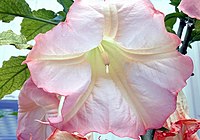
Photo from wikipedia
Abstract. Tolangara A, Corebima AD, Mas'ud A, Sundari. 2020. Short Communication: Genetic diversity of lemon (Citrus spp.) from Ternate Island (Indonesia) based on morphological and molecular characters. Biodiversitas 21: 1908-1913.… Click to show full abstract
Abstract. Tolangara A, Corebima AD, Mas'ud A, Sundari. 2020. Short Communication: Genetic diversity of lemon (Citrus spp.) from Ternate Island (Indonesia) based on morphological and molecular characters. Biodiversitas 21: 1908-1913. One effort to build the image of Indonesian lemon can be by utilizing local genetic resources of Citrus spp. One of the growth centra lemon regions in North Maluku is Ternate Island. In Ternate island, cui (C. macrocarpa) is dominantly cultivated besides that there are Suanggi (C. histryx), nipis (C. aurantiifolia), and lemon (C sinensis). The genetic diversity of these local lemons in North Maluku, especially in Ternate, has not been scientifically reported. Therefore, this study aimed to analyze the genetic diversity of local lemons found on the island of Ternate based on morphological character and RAPD molecular analyses. A total of 12 accessions of local lemons in Ternate island to studied for morphological and molecular characters. Observation of morphological and morphometric characters of the lemons on 117 characters of vegetative and generative organs in lemons. Observation of molecular characters using three primers, i.e.: OPA1, OPA 2, and OPA 3 in the RAPD technique. The morphological character and molecular character using UPGMA analysis showed similar results. Ternate Island has moderate diversity of lemon species (75% based on morphological characters and 73% based on RAPD markers). Cluster analysis indicates that cui (C. macrocarpa) has the most distinctive autapomorphic character compared to the other local lemon varieties. Nipis (C.auratiifolia) and Suanggi (C. hystrix) shared 75% synapomorphic character similarity. This genetic diversity information provides a novel insight into the lemon commodity breeding programs which can be encouraged through the selection of superior local lemons based on morphological and molecular markers.
Journal Title: Biodiversitas
Year Published: 2020
Link to full text (if available)
Share on Social Media: Sign Up to like & get
recommendations!